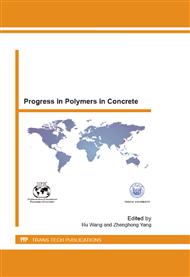p.329
p.335
p.341
p.347
p.354
p.359
p.369
p.378
p.384
Thermodynamics of the Polymer-Concrete Interface
Abstract:
Property of polymer-concrete in the interface has been dealt with from the view of thermodynamics. Gibbs function or free enthalpy was applied to characterize the binding ability of the interface. AC impedance spectroscopy was used to measure the electrical capacitance of the interface between the polymer particle and mortar. Lippmann equation was used to estimate the thermodynamic functions for the estimation of the binding ability. A typical example was given.
Info:
Periodical:
Pages:
354-358
Citation:
Online since:
April 2013
Authors:
Price:
Сopyright:
© 2013 Trans Tech Publications Ltd. All Rights Reserved
Share:
Citation:


